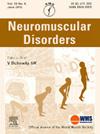杜氏肌营养不良症患者行走能力丧失年龄与心功能的关系。
IF 2.7
4区 医学
Q2 CLINICAL NEUROLOGY
引用次数: 0
摘要
心肌病是杜氏肌营养不良症(DMD)患者常见的合并症。本回顾性单中心研究调查了84例(16岁至16岁)DMD患者服用糖皮质激素和ACE抑制剂治疗时丧失活动能力年龄(LOA)与晚期左室射血分数(LVEF)之间的关系。回归分析显示,LOA年龄较晚与成年期较高的LVEF呈正相关(线性回归估计1.49,95% CI: 0.13-2.84, p = 0.03)。每增加一年的活动,显示较高LVEF类别(LVEF 40%, 40 - 50%或50%)的几率增加35% (p = 0.003)。排除心脏保护基因型(Dp116亚型缺失)和轻度运动表型(可跳过44和45外显子的框外缺失)的敏感性模型证实了这种关联,而包括呼吸障碍年龄的模型并未改善模型。在11.92岁之前失去行走能力的个体(ROC AUC 0.73, 95% CI: 0.60-0.85)达到LVEF本文章由计算机程序翻译,如有差异,请以英文原文为准。
Association between age at loss of ambulation and cardiac function in adults with Duchenne muscular dystrophy
Cardiomyopathy is a common co-morbidity in individuals with Duchenne muscular dystrophy (DMD). This retrospective single centre study investigated the relationship between age at loss of ambulation (LOA) and late stage left ventricular ejection fraction (LVEF) in 84 individuals (> 16 years old) with DMD taking glucocorticoid and ACE inhibitors treatment. Regression analyses showed a positive correlation between later age at LOA and higher LVEF in adulthood (linear regression estimate 1.49, 95 % CI: 0.13–2.84, p = 0.03). Each additional year of ambulation increased the odds of displaying a higher LVEF category (LVEF 40 %, 40 – 50 % or 50 %) by 35 % (p = 0.003). Sensitivity models excluding cardioprotective genotypes (absence of Dp116 isoform) and mild motor phenotypes (out of frame deletions amenable to skip exon 44 and 45) confirmed this association while models including age at respiratory impairment did not improve the model. Individuals who lost ambulation before age 11.92 (ROC AUC 0.73, 95 % CI: 0.60–0.85) reached a LVEF <40 % 5.21 years earlier than those who lost ambulation after that age (adjusted restricted mean survival time 19.08 vs 24.29 years, p < 0.001). These findings may suggest that prolonging ambulation does not impact cardiac function adversely in advance stages of DMD.
求助全文
通过发布文献求助,成功后即可免费获取论文全文。
去求助
来源期刊

Neuromuscular Disorders
医学-临床神经学
CiteScore
4.60
自引率
3.60%
发文量
543
审稿时长
53 days
期刊介绍:
This international, multidisciplinary journal covers all aspects of neuromuscular disorders in childhood and adult life (including the muscular dystrophies, spinal muscular atrophies, hereditary neuropathies, congenital myopathies, myasthenias, myotonic syndromes, metabolic myopathies and inflammatory myopathies).
The Editors welcome original articles from all areas of the field:
• Clinical aspects, such as new clinical entities, case studies of interest, treatment, management and rehabilitation (including biomechanics, orthotic design and surgery).
• Basic scientific studies of relevance to the clinical syndromes, including advances in the fields of molecular biology and genetics.
• Studies of animal models relevant to the human diseases.
The journal is aimed at a wide range of clinicians, pathologists, associated paramedical professionals and clinical and basic scientists with an interest in the study of neuromuscular disorders.
 求助内容:
求助内容: 应助结果提醒方式:
应助结果提醒方式:


